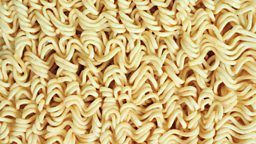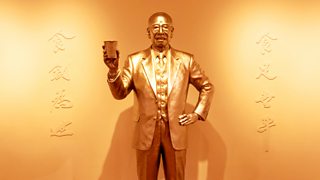From pot to slurp: oodles of noodle facts
They can be stretched, extruded, or rolled flat; boiled and bunged in soup, fried and tossed with seafood or even dehydrated and sold in their own cup, as The Eternal Life of the Instant Noodle explores. One thing is for sure: however noodles are created, cooked and eaten, this versatile food is one of the world’s best-loved staples.

1. Noodles are at least 4000 years old
In 2002, a bowl of noodles thought to be 4000 years old was unearthed in Qinghai province, China. The earthenware bowl and its preserved contents were discovered buried underneath three metres of sediment at an archaeological site in Lajia, the location of a catastrophic earthquake some four millennia ago. Before this find, the earliest record of noodles appeared in a book written during China's Eastern Han Dynasty, sometime between 25 and 220 AD.
-
![]()
The Eternal Life of the Instant Noodle
How instant noodles went global with the help of students, travellers and prisoners.
2. The name noodle is German
The noodle may be Asian in origin but the food’s name most likely has its roots in the German language. It is thought that “noodle” comes from the German word “nudel” which itself comes from “knödel”, meaning dumpling. This in turn derives from the Latin word “nodus” meaning knot. That’s etymology that needs some serious untangling.

3. The instant noodle was invented to cure world hunger
After Japan's defeat in WWII, food supplies were scarce and the people were reliant on American aid. Momofuku Ando, a failed Taiwanese-Japanese businessman, was intent on finding a way to feed Japan's starving post-war population, convinced that real peace would only come when they had enough to eat. So, he spent a year working away in a backyard hut in Osaka and, through tireless endeavour and trial and error, emerged with what would become the world's most successful industrial food: the chicken ramen instant noodle. Instant noodles first went on sale in 1958, and they've changed little since.
4. Hundreds of millions of instant noodles are eaten around the world each day
60 years on from Ando’s garden shed creation, 270 million servings of instant noodles are now eaten around the world every day according to the World Instant Noodles Association. Annually, that's 16 to 17 portions for every man, woman and child. Last year alone we ate more than 100 billion servings of them across the globe, with 38 billion of those consumed in Mainland China – the world’s number one market for “convenient noodles.”
5. Japan has three museums dedicated to instant noodles
At the turn of the millennium, a poll found that the Japanese believe their best invention of the twentieth century is instant noodles – ahead of high-speed trains, the laptop and karaoke! The country has not one but three instant noodle museums, with the museum in Yokohama dedicated entirely to Cup Noodles.
6. In Japan, slurping noodles is considered polite
In Japan, slurping loudly while eating your noodles is not considered rude but rather a sign of appreciation. If you’re sitting down to a bowl of noodles in the Land of the Rising Sun, use your chopsticks to guide the noodles into your mouth and then slurp them, loudly. This shows your host that you are enjoying the meal with the added benefit of enhancing the flavour.


7. Instant noodles are the most traded legal item in US prisons
Latest research shows that instant noodles have replaced cigarettes as the most traded item in US prisons. With prison budgets being slashed, most prisoners are only fed the minimum number of calories legally required. As a result, cheap, instant noodles have become a favourite purchase from the prison commissary and have emerged as a type of currency, commonly used as payment.
8. In China, noodles symbolise a long life
Noodles are a symbol of longevity in China, with a long noodle symbolising a long life in Chinese tradition. “Longevity noodles”, which are longer than normal noodles and either fried or boiled in broth, are often served at Chinese New Year celebrations. It is considered very unlucky to cut up a strand!

9. The Koreans are nutty for a noodle made from acorns
In Korea, there is a variety of noodle made from the nut of the oak tree. Acorn noodles, or dotori guksu, are made from a combination of acorn flour and other grain-based flours like wheat or buckwheat flour. The acorn flour itself can come from either red or white oak trees, with each species’ nut providing a distinct flavour.
10. The world’s longest noodle was over 3km in length
The Guinness World Record for the longest noodle belongs to a Chinese food company who successfully cooked a single strip measuring a whopping 3,084 metres. Staff from Xiangnian Food Co. Ltd spent 17 hours rolling out the enormous noodle, which was made from a traditional ramen recipe and included 40 kg of bread flour, 26.8 litres of water and 0.6 kg of salt. The adjudicator had to check that the noodle was just one string and not several noodles joined together in order for the record to stand – a task that took three hours.
-
![]()
The Eternal Life of the Instant Noodle
How instant noodles went global with the help of students, travellers and prisoners.
-
![]()
How instant noodles went global - with the help of students, workers and prisoners.
-
![]()
The Invention of Instant Noodles
The creation in 1958 of a new product that would revolutionise mealtimes worldwide
-
![]()
The Food Programme: Pasta
Sheila Dillon looks behind the scenes of the world's largest and smallest pasta factories.




